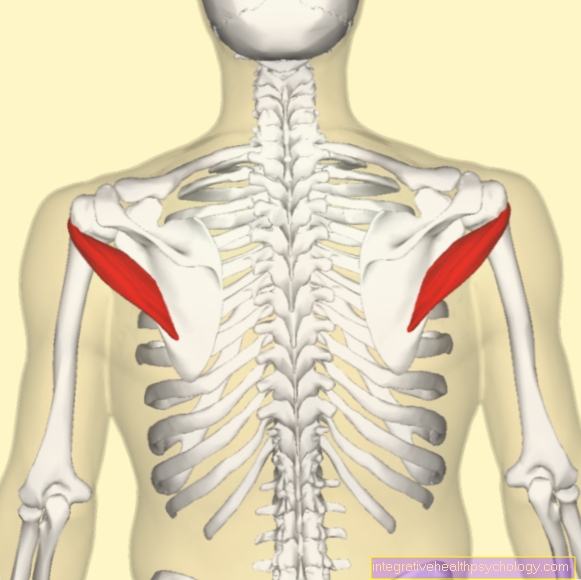Flu or cold? - Those are the differences
synonym
Rhinitis, cold, cold, runny nose, flu-like infection
introduction
Colloquially, there is often no distinction between the terms flu, cold or flu-like infection.
This is not at all easy based on the symptoms, since both the flu (influenza) and a cold (flu-like infection) are coughs, sore throats and fatigue as the main complaints.
However, there are certain differences between the two clinical pictures and it is important to distinguish between them, since a cold is bothersome, but usually heals without any problems.
The flu, on the other hand, is to be taken very seriously as a disease, as it is usually more severe. The flu, especially in the elderly or debilitated, is at risk of serious complications, such as pneumonia.

Different triggers
Both the flu and the common cold are transmitted via droplet infection.This means that the pathogens get from person to person when coughing or sneezing, for example. Transmission can also take place via direct contact, for example when washing hands or touching a door handle.
A big difference between the two diseases are these pathogens, namely the different types of viruses.
A cold can be triggered by a large number of different cold viruses; in total, well over 100 different viruses can trigger a cold. The majority of colds are caused by so-called rhinoviruses.
Influenza flu is caused by only one type of virus, the so-called influenza virus.
The time of year also plays an important role. Colds occur primarily during the cold season, while the flu can occur year-round. Although more common in winter there is also the so-called summer flu.
Further information on this:
- Frequency of the flu
- Cause of the flu
Symptom comparison
A cold tends to creep in, while the flu usually has a very sudden onset of illness.
The symptoms of the flu are characterized by a high fever (over 39 degrees Celsius) and a pronounced feeling of illness. Colds, on the other hand, usually show no increase in body temperature. Typically, a runny nose and a stuffy nose occur with a cold, and a sore throat also shows itself at the beginning as an unpleasant "scratching" in the throat, while these symptoms occur rarely with influenza.
Coughing often occurs in the course of a cold, while flu often starts with a dry cough. As a rule, flu is also accompanied by headaches, muscle and limb aches and severe tiredness and exhaustion. V Muscle and limb pain are also typical of a cold, but headaches only occur partially, and tiredness and a general feeling of illness are only moderately pronounced. Usually everything is over after a week. The flu usually lasts much longer than a cold and is often associated with the typical symptoms of loss of appetite, chills and sometimes shortness of breath.
Read more about this:
- Symptoms of the common cold
- Symptoms of the flu
- Fever with aching limbs.
diagnosis
Both the flu and the common cold can sometimes be different and not have all of the typical symptoms. A correct differentiation is therefore not always possible for medical laypeople and, in case of doubt, it is always advisable to consult a doctor for an exact diagnosis.
Alternatively, there are now over-the-counter flu rapid tests that can also be carried out at home and detect the flu pathogen. Then a cold can be excluded.
Read more about this at:
- Rapid flu test
- Diagnosis of the flu
Flu or cold - what is the right thing to do?

The most important measure is to take it easy. It doesn’t matter whether it’s the flu or a cold. Both diseases weaken the body to such an extent that it should not be exposed to unnecessary stress.
Particularly sporting activities or saunas should be avoided if you have a cold. Because of the very pronounced feeling of illness, the person affected is forced to take it easy in the event of the flu. It is advisable to stay in bed for a few days to give the body time to recover. Basically, after the flu, the person affected should take it easy for a while after the symptoms have subsided.
The typical symptoms associated with both the flu and the common cold, such as a cough, runny nose, and sore throat, can be treated with over-the-counter medications.
The new generation of cold sprays (with a decongestant drug and additional mucous membrane protection dexpanthenol), cough suppressants, cough relievers or throat tablets can alleviate the symptoms.
Headache and body aches can be treated with pain relievers (e.g. acetysalicylic acid, ASA), and peppermint oil can also help with headaches. Proven home remedies such as leg compresses, sage tea, potato compresses on the chest, inhalation with chamomile or gargling can provide relief.
Caution is advised with viral infections in children. Under no circumstances should children be given salicylates (e.g. acetylsalicylic acid), as there is a risk of Reye's syndrome (serious illness with damage to the brain and liver).
If you have mild flu, usually bed rest and the medications listed above will help relieve symptoms. In the case of severe flu, there is the possibility of fighting the virus with special antiviral drugs (antivirals). However, this only makes sense if the medication is used within 48 hours.
In rare cases, there is also an infection with bacteria, which can develop, for example, an inflammation of the sinuses (sinusitis), inflammation of the airways (bronchitis) or pneumonia. These diseases are usually treated with antibiotics, but only when bacteria have been identified as the trigger. Antibiotics cannot do anything against viruses!
- Treating the flu
- Therapy of the common cold
prevention
It is possible to prevent the flu with the flu vaccination.
The Standing Vaccination Commission (STIKO) recommends that people over 60 years of age, pregnant women from the second trimester of pregnancy, residents of old people's or nursing homes and people at increased risk (e.g. medical and nursing staff) have the flu vaccination annually.
In addition, the vaccination is also recommended for children, adolescents and adults with an increased health risk as a result of an underlying disease (e.g. chronic lung, liver, kidney diseases, diabetes mellitus).
A vaccination protects up to 90 percent of those vaccinated against influenza or significantly alleviates the course of the disease. However, the flu vaccination does not protect against a cold.
A cold can be prevented with a strong immune system. Sufficient exercise, a healthy diet and regular sauna sessions can help keep the body's immune defenses fit. Contact with people with a cold (e.g. in unventilated rooms in winter) should be avoided if possible. In addition, hands should be washed regularly and thoroughly, because the viruses can easily be transmitted from person to person or from door handles, railings or handles on the bus via the hands to the own mucous membranes.
Read more about this: Prevent flu
Summary

The common cold is often mistaken for the corresponding symptoms of the flu.
The following differences should be noted: the flu is caused by the influenza virus. This changes its outward appearance every season and has to be identified again and again in order to be able to manufacture a vaccine. The onset of a cold or a flu-like infection is insidious, accompanied by a slight headache, sore throat, fatigue, sweating and runny nose. The fever that may have set in is rather light, the cough is often only weak.
The flu comes on quickly and is accompanied by severe to very severe headaches, high fever and dry cough. In addition, patients with the flu often complain of severe pain in their limbs, circulatory problems and fatigue. The common cold usually disappears after a few days. The influenza (flu) can last up to 14 days.
You may also be interested in this topic: Flu complications





























